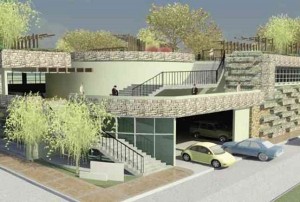Their assignment: Come up with the best ideas to make the city green.
In 2011, the Green Urban Design Center (GUDC) at the University of Makati started conducting six-week workshops for officials from the city’s 33 barangays, crash courses which introduced them to the basic concepts of urban planning, sustainable landscape design and public space management, among others.
Two years after the program opened, the Saturday sessions have produced plans and designs worth trying for the citizens of Makati, visions that can be turned into reality with enough funding and political will from their leaders.
According to Violeta Seva, a senior adviser to Mayor Jejomar Erwin Binay, City Hall is considering holding a competition among the barangays within the year—with a P2-million prize that can serve as “seed money” for the winning village to implement the plans developed at GUDC.
Most villages, like San Lorenzo, came up with ideas as simple as setting up rooftop gardens on their barangay halls or horizontal gardens on their walls. Other designs incorporated the use of energy-efficient lighting and appliances.
Officials from Barangay Pitogo suggested putting up a recycling facility, complete with solar panels and rainwater harvesters.
Barangay Cembo proposed a neighborhood vegetable farm to be called “Oh May Gulay! (OMG)” while Barangay Pio del Pilar suggested having linear parks along the Tripa de Galina.
Barangay Pembo explored the “adaptive reuse” of underground tunnels found in the area—which was once part of a military reservation—by turning them into tourist attractions.
But not all ideas involved building structures. Barangay Lorenzo, for example, proposed the observance of “Meatless Mondays.”9:15 PM 7/20/2013
Other villages pushed for environment-friendly transports like electronic and pedal-powered tricycles.
The GUDC was set up so that barangay leaders can make “a shift from (just) being local politicians to planners of our individual communities,” said Mayor Binay during the presentation of the officials’ outputs last year.
Barangay East Rembo chair Artemio Contreras also noted that the GUDC “does not only help improve the physical environment of the barangays, but also initiates change in the residents’ lifestyle.”
The city government implemented the program in coordination with the University of the Philippines’ School of Urban and Regional Planning Alumni and Friends Foundation Inc.
Makati Department of Environmental Services head Danilo Villas also expressed hope that the ideas cultivated at GUDC would help reduce the city’s greenhouse gas emissions.
The city government has begun drawing up a greenhouse gas inventory based on the power, water and fuel consumption and the amount of solid waste generated by its residents and business establishments.
The inventory has gathered data starting from 2011, showing that government buildings in Makati alone produce 12,000 tons of carbon dioxide annually, Villas said.
“You already know your sources, now you can have the interventions,” he said, citing the main rationale for putting up the GUDC.
